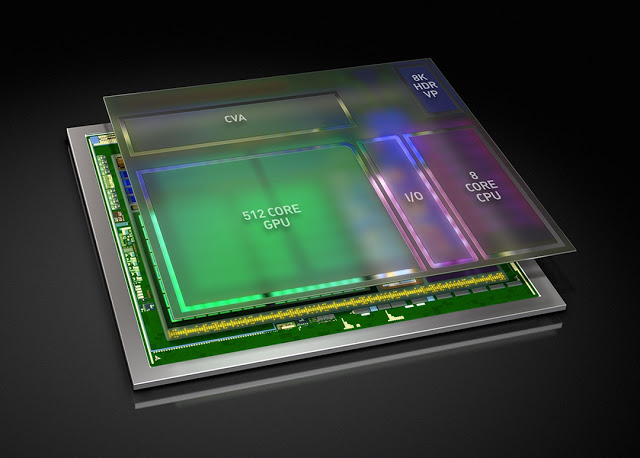Nvidia Xavier is a complete system-on-chip (SoC), integrating a new GPU architecture called Volta, a custom 8 core CPU architecture, and a new computer vision accelerator. The processor will deliver 20 TOPS (trillion operations per second) of performance, while consuming only 20 watts of power. As the brain of a self-driving car, Xavier is designed to be compliant with critical automotive standards, such as the ISO 26262 functional safety specification.
At the inaugural GPU Technology Conference Europe, NVIDIA CEO Jen-Hsun Huang today unveiled Xavier, our all-new AI supercomputer, designed for use in self-driving cars.
Packed with 7 billion transistors, and manufactured using cutting-edge 16nm FinFET process technology, a single Xavier AI processor will be able to replace today’s DRIVE PX 2 configured with dual mobile SoCs and dual discrete GPUs — at a fraction of the power consumption.
Because autonomous driving is an incredibly compute-intense process, the need for an efficient AI processor is paramount. Xavier will bring self-driving car technology to automakers, tier 1 suppliers, startups and R&D organizations that are building autonomous vehicles, whether cars, trucks, shuttles or taxis.
Xavier samples will be available the fourth quarter of 2017 to automakers, tier 1 suppliers, startups and research institutions who are developing self-driving cars.
At NVIDIA’s GTC Europe 2016 conference, Nvidia showed next generation Tegra SoC, which the company is calling Xavier. NVIDIA laid out enough information to make it clear that the Tegra group has left mobile behind for good, and now the company is focused on high performance SoCs for cars and other devices further up the power / performance spectrum.
Volume shipments won’t even be until 2018.

Brian Wang is a Futurist Thought Leader and a popular Science blogger with 1 million readers per month. His blog Nextbigfuture.com is ranked #1 Science News Blog. It covers many disruptive technology and trends including Space, Robotics, Artificial Intelligence, Medicine, Anti-aging Biotechnology, and Nanotechnology.
Known for identifying cutting edge technologies, he is currently a Co-Founder of a startup and fundraiser for high potential early-stage companies. He is the Head of Research for Allocations for deep technology investments and an Angel Investor at Space Angels.
A frequent speaker at corporations, he has been a TEDx speaker, a Singularity University speaker and guest at numerous interviews for radio and podcasts. He is open to public speaking and advising engagements.













